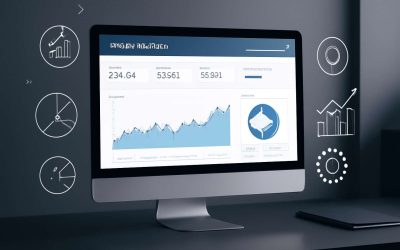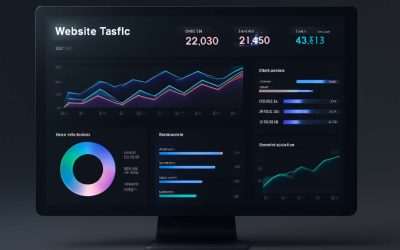Understanding Website Traffic Reports
Definition of Website Traffic Report – Explaining what a website traffic report is
A website traffic report is a vital tool for understanding how visitors interact with your online presence. It provides a detailed snapshot of key metrics such as the number of visitors, page views, bounce rates, and the sources driving traffic to your site. Essentially, it answers the question: what is website traffic report, and why should you care?
By analysing this data, website owners and marketers can identify patterns, optimise content, and refine marketing strategies. For instance, knowing which channels bring in the most visitors helps allocate resources more effectively. A traffic report isn’t just about numbers; it’s about uncovering the stories behind those numbers and making informed decisions to improve online visibility.
Understanding what is website traffic report is crucial for anyone serious about harnessing the full potential of their website. It transforms raw data into actionable insights, giving you a clearer picture of your digital footprint.
Importance of Website Traffic Data – Reasons why analyzing website traffic is crucial for online success
Understanding website traffic reports is like opening a window into the heartbeat of your online presence. Every visitor, every click, and every moment spent on your site tells a story—one that can reveal hidden opportunities and silent struggles. When you ask yourself, “what is website traffic report,” you’re seeking a mirror that reflects your site’s real-world impact.
Analyzing website traffic data is essential because it uncovers patterns that might otherwise go unnoticed. You might find that most visitors arrive through specific channels or that certain pages hold their attention longer. This insight can shape your content and marketing efforts, ensuring resources are directed where they matter most.
- Identifying which sources drive the highest traffic
- Understanding peak visitor times
- Detecting drop-off points that need attention
Ultimately, knowing what is website traffic report empowers you to make informed decisions, transforming raw data into a powerful tool for growth. It’s about seeing your digital footprint clearly—like a farmer reading the signs of the land—so you can nurture your online presence with purpose and clarity.
Components of a Typical Traffic Report – Key metrics and data points included in traffic reports
Understanding website traffic reports reveals a symphony of data points that paint a vivid picture of your digital landscape. These reports are not mere numbers; they are the pulse of your online presence, capturing the ebb and flow of visitors with poetic precision. Central to this understanding are key metrics that serve as the compass guiding your strategy.
- Visitor count: The total number of individuals crossing your virtual threshold, each one a story unfolding.
- Traffic sources: The pathways—search engines, social media, referrals—that channel visitors to your site.
- Page views: The pages that beckon most, revealing what content captures the eye and holds attention.
- Bounce rate: The silent signal indicating how often visitors leave after a fleeting glance.
- Session duration: The time visitors spend immersed in your site’s narrative, a measure of engagement.
These components, woven together, transform raw data into insights that illuminate your website’s hidden stories. When you ask, “what is website traffic report,” you unlock a treasury of understanding, revealing not only where your visitors come from but also where your efforts should be directed to foster growth.
Key Metrics in Website Traffic Reporting
Visits and Unique Visitors – Difference between total visits and unique visitors
Understanding key metrics in a website traffic report reveals the true picture behind visitor behaviour. One of the most fundamental distinctions is between visits and unique visitors. Visits, also known as sessions, count each time a user interacts with your website within a specific timeframe. Multiple visits by the same person are recorded separately. In contrast, unique visitors refer to the total number of individual users who access your site, regardless of how often they return.
This difference is crucial for SEO analysis because it helps identify whether your audience is growing organically or merely returning existing visitors. For example, a high number of visits with a relatively low count of unique visitors suggests strong user retention but limited new reach. Conversely, a steady rise in unique visitors indicates effective outreach and expanding visibility.
To better grasp your website’s performance, consider these metrics as part of your overall review of what is website traffic report:
- How many users are genuinely new to the site
- How often returning visitors engage with your content
These insights are vital for tailoring your SEO strategy and understanding your audience’s true engagement levels.
Page Views and Session Duration – Understanding engagement metrics
Understanding how visitors engage with your website goes beyond just counting numbers. Key metrics like page views and session duration unlock the story behind your traffic data. Page views reflect how many times your content is loaded — the more views, the higher the potential interest in your site’s offerings. Meanwhile, session duration reveals how long visitors stay during each visit, offering a window into their level of engagement. A lengthy session often indicates compelling content that holds attention, whereas brief visits might suggest a disconnect or unmet expectations.
Tracking these metrics helps you gauge the effectiveness of your SEO efforts. For example, a spike in page views paired with longer sessions could be a sign that your optimisation strategies are resonating with your audience. Conversely, low session durations might highlight areas needing improvement. By analysing what is website traffic report, you gain precise insights into visitor behaviour, enabling you to refine your content and outreach for smarter, more targeted growth.
Traffic Sources – Identifying where visitors come from (organic, direct, referral, social)
Understanding where your visitors originate from is as essential as knowing why they are clicking through your digital doors. In the realm of a what is website traffic report, traffic sources shed light on the pathways leading audiences to your virtual doorstep. Whether they arrive via organic search, a direct URL entry, referral links from other sites, or through social media platforms, each source narrates a different story about your outreach efforts.
By dissecting these sources, you gain clarity on which channels perform best and where your SEO strategies are bearing fruit. For instance, a surge in organic traffic often signifies successful optimisation, while social media referrals might hint at burgeoning engagement across platforms. To truly grasp your site’s story, monitoring these traffic sources allows you to adapt and refine your approach, ensuring that your content reaches the right eyes—wherever they may be lurking online.
Bounce Rate and Exit Rate – Measuring visitor behavior and engagement
Within the enchanted realm of your website’s analytics, bounce rate and exit rate serve as vital compass points—guiding you through the labyrinth of visitor behaviour and engagement. The bounce rate reveals the percentage of visitors who step onto your digital stage but depart after viewing only a single page, like a fleeting spectre passing through. Meanwhile, the exit rate illuminates where visitors ultimately leave your site, offering clues about potential bottlenecks or content disconnects. Understanding these metrics is akin to reading the faint, ancient runes that tell the story of your audience’s journey.
In the grand tapestry of what is website traffic report, these insights help unravel the elusive patterns of engagement. When crafted with care, they expose the pathways your visitors traverse—and where they lose interest. For example, a high bounce rate on a key landing page might signal the need for enchantments to captivate your audience further. Conversely, a low exit rate on engaging content hints at a successful spell of connection, reinforcing the importance of monitoring these key metrics in your digital quest.
Conversion Rate – Tracking goal completions and conversions
Tracking how visitors convert into customers is the heartbeat of a comprehensive website traffic report. Conversion rate measures the percentage of visitors who complete a desired action—be it making a purchase, signing up for a newsletter, or filling out a contact form. This metric provides a clear view of how effective your site is at turning interest into tangible results.
A high conversion rate signals that your content and user experience resonate with your audience. Conversely, a low rate might highlight areas needing refinement. To gain a deeper understanding, many marketers track goal completions, which are specific actions aligned with business objectives. These insights can reveal which campaigns or pages truly drive success.
In essence, the question of what is website traffic report isn’t complete without recognising how well your site converts visitors into leads or customers. It’s the bridge between traffic volume and meaningful engagement—crucial for SEO and overall online growth.
Tools for Generating Website Traffic Reports
Google Analytics – Features and benefits of Google Analytics for traffic analysis
In the realm of digital alchemy, Google Analytics stands out as a masterful tool for generating website traffic reports that unveil the secret pathways traversed by visitors. It transforms raw data into a vivid tapestry of insights, revealing where your audience originates and how they interact with your content. This tool’s brilliance lies not only in its ability to track numerous metrics but also in its capacity to connect dots that might otherwise remain hidden.
Google Analytics offers a treasure trove of features that make understanding traffic both intuitive and profound. It provides detailed reports on traffic sources, user behaviour, and engagement levels, allowing you to see exactly what is driving visitors to your site. For those seeking clarity, the platform’s dashboard consolidates data into an elegant interface, making complex information accessible at a glance. This empowers marketers to craft strategies rooted in real-world behaviour, ensuring every effort is optimised for maximum impact.
- Real-time data tracking for instant insights
- Customisable reports tailored to specific goals
- Intuitive visualisations that tell a compelling story
With Google Analytics, understanding what is website traffic report becomes an enchanting journey—one that reveals the unseen currents shaping your online presence. Its benefits extend beyond mere numbers; they illuminate the very soul of your digital landscape, guiding you through the labyrinth of online engagement with clarity and purpose.

Other Analytics Platforms – Overview of alternative tools (Hotjar, SEMrush, Matomo)
While Google Analytics often steals the spotlight in traffic analysis, there exists a constellation of alternative tools that can cast new light on your website’s performance. These platforms offer unique perspectives and specialised features that enrich your understanding of what is website traffic report. For instance, Hotjar provides visual heatmaps and visitor recordings that reveal exactly how users interact with your pages, transforming raw data into visual storytelling.
SEMrush, renowned for its SEO prowess, delivers comprehensive traffic insights alongside competitive analysis. It’s like having a crystal ball that not only shows your traffic sources but also how your rivals are capturing their visitors. Meanwhile, Matomo champions privacy and customisation, allowing you to harness detailed traffic reports without compromising user confidentiality.
- Heatmaps
- Real-time analytics
- Keyword tracking
These tools exemplify the vibrant ecosystem of traffic analysis, each adding a different hue to your understanding of what is website traffic report.
Integrating Traffic Data with SEO Strategies – How to leverage tools for SEO improvements
Understanding what is website traffic report extends beyond mere numbers; it embodies a nuanced narrative of visitor behaviour, engagement, and digital footprints. Integrating traffic data with SEO strategies transforms raw analytics into a potent arsenal for optimisation. For instance, leveraging tools like SEMrush or Hotjar allows insights not only into traffic sources but also into the subconscious patterns guiding user interaction. This depth of understanding unveils opportunities to refine content, enhance user experience, and ultimately elevate search engine rankings.
Incorporating these insights involves a layered approach—prioritising key metrics such as bounce rate, session duration, and conversion rate—while examining the qualitative aspects of visitor behaviour. An ordered list can clarify the process:
- Identify high-traffic keywords and sources.
- Analyse user interaction patterns via heatmaps or recordings.
- Refine SEO strategies based on behavioural data.
- Continuously monitor shifts in traffic and engagement to adapt tactics in real time.
This seamless integration of traffic reports with SEO efforts creates a feedback loop—each dataset informing the next move—culminating in a website optimisation cycle that is as fluid as it is data-driven. Recognising what is website traffic report is not merely an exercise in data collection; it’s a gateway to understanding the visceral relationship between your digital presence and its audience, driving strategic decisions that resonate on a profoundly human level.
Interpreting and Using Website Traffic Reports
Analyzing Trends Over Time – Monitoring traffic trends and seasonality
Understanding what is website traffic report goes beyond just numbers; it’s about uncovering the story behind visitor behaviour. When analysing traffic reports over time, patterns become clear—showing when your audience is most active or when seasonal fluctuations impact your site’s performance. Monitoring these trends helps identify peaks and valleys in traffic, allowing you to optimise your SEO strategies effectively.
Seasonality, for instance, can significantly influence visitor volume, making it crucial to compare data across different periods. By doing so, you gain insight into whether fluctuations are due to external factors or changes in your content. Recognising these patterns enables a more strategic approach to content planning, keyword targeting, and user engagement initiatives—ultimately boosting your site’s visibility.
Tracking the evolution of traffic over extended periods reveals valuable information about your site’s growth trajectory. It’s not just about immediate gains but understanding long-term shifts—helping you refine your SEO efforts and allocate resources where they’ll make the biggest impact.
Identifying High-Performing Content – Using data to focus on successful pages
In the vast digital landscape, understanding which pages captivate your visitors is akin to discovering the hidden constellations guiding your online voyage. A well-crafted website traffic report reveals these luminous points of success, shining a spotlight on your most high-performing content. When you decipher which pages resonate most, you unlock the secret to amplifying your SEO efforts — focusing your energies where they matter most.
By examining the data, you can identify patterns that highlight content that sparks engagement and drives conversions. This insight helps you fine-tune your keyword targeting and content creation, ensuring your site remains a magnetic force in search rankings. Remember, it’s not just about seeing what’s popular now, but understanding why certain pages stand out, paving the way for a more strategic and enchanting approach to your digital storytelling.
Assessing Campaign Effectiveness – Evaluating marketing efforts based on traffic data
Assessing the efficacy of marketing campaigns demands more than intuition; it requires a meticulous interpretation of traffic data, revealing nuanced insights into visitor behaviour and engagement. A well-constructed website traffic report functions as a digital compass, guiding strategic decisions with precise metrics. By examining fluctuations in traffic sources and identifying peaks or troughs, marketers can discern which efforts resonate most profoundly with their audience.
Understanding what is website traffic report extends beyond raw numbers—it is about uncovering the story behind each click, each visit, and each bounce. When you evaluate campaign effectiveness, you’re essentially decoding a complex symphony of user interactions, pinpointing which melodies strike a chord and which fall flat. This process enables a more refined focus on optimisation, ensuring that efforts are directed toward channels and content that genuinely drive growth and conversion.
Making Data-Driven SEO Decisions – Utilizing report insights to optimize SEO tactics
Interpreting and harnessing website traffic reports transforms raw data into a potent instrument for refining SEO strategies. When you delve into the intricacies of these reports, you begin to see beyond mere numbers—each metric narrates a fragment of a larger user behaviour mosaic. Recognising patterns in traffic sources, for instance, reveals which channels—be they organic search, social media, or referral links—are genuinely driving engagement. This insight enables targeted optimisation, ensuring efforts are allocated where they matter most.
By analysing fluctuations over time, marketers can detect seasonal trends or the impact of recent campaigns. This dynamic understanding fosters a proactive approach to SEO, where content adjustments and keyword focus evolve in response to real-world visitor interactions. Employing tools like Google Analytics or alternative platforms such as SEMrush or Hotjar can deepen these insights, revealing subtle behavioural cues. Ultimately, a well-interpreted website traffic report becomes a compass, steering strategic decisions with clarity and confidence.
Best Practices for Monitoring Website Traffic
Regular Reporting Schedule – Establishing consistent review routines
Establishing a regular reporting schedule for monitoring website traffic is vital to understanding the ebb and flow of visitor behaviour. When you consistently review your traffic data, patterns emerge that can inform your SEO strategies, helping you pinpoint what is website traffic report revealing about your site’s performance.
A heartbeat of this process is consistency. For example, setting aside a specific time each week or month to scrutinise your analytics ensures you stay attuned to shifts and trends. This routine fosters a deeper understanding of your audience and allows for timely adjustments.
Some businesses find it helpful to utilise a mix of tools—Google Analytics, Hotjar, or SEMrush—to gather comprehensive insights. Creating a structured review schedule—perhaps breaking down focus areas in a systematic way—can turn raw data into actionable intelligence, ensuring your SEO efforts are always aligned with evolving traffic patterns.
Customizing Reports for Your Goals – Tailoring data views to business objectives
In the vast ocean of digital presence, understanding what is website traffic report can be akin to navigating with a lighthouse—illuminating unseen currents and hidden shoals. Tailoring these reports to your unique business goals transforms raw data into a symphony of insights, guiding strategic decisions with precision and grace. When metrics are customised—focusing on conversion rates, traffic sources, or engagement levels—you gain clarity on how your audience interacts with your digital domain.
Imagine a customised traffic report as a bespoke map, highlighting the pathways that lead visitors to your site and revealing where they linger or depart. By aligning your data views with specific objectives—whether boosting organic reach or refining content strategy—you craft a clearer picture of your site’s performance. The art lies in choosing the right metrics and visualising them in a way that resonates with your vision, ensuring every insight fuels your SEO endeavours and propels your online presence forward with purpose.
Prioritizing Data for Action – Focusing on actionable insights
In the labyrinth of digital strategy, where every click and scroll shapes your online destiny, prioritising data for action becomes a dance of finesse and precision. A well-crafted website traffic report reveals the hidden symphony behind visitor behaviour, transforming raw numbers into a language of opportunity. By focusing on actionable insights—such as pinpointing high-converting pages or understanding elusive bounce rates—you unlock the secrets that propel your SEO efforts forward.
Understanding what is website traffic report is only the beginning. The true art lies in filtering the noise, spotlighting metrics that matter most to your business. Whether it’s identifying traffic spikes or analysing referral sources, each insight acts as a compass pointing you towards optimisation. In this pursuit, clarity and agility are your allies—guiding decisions that turn visitors into loyal patrons and elevating your digital presence from mere existence to compelling influence.



0 Comments